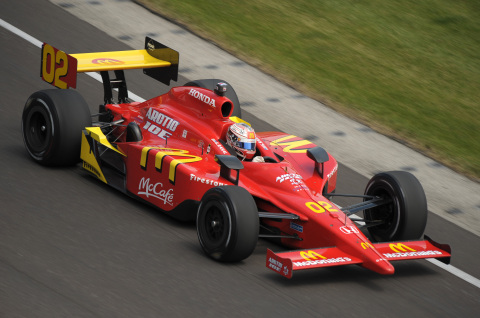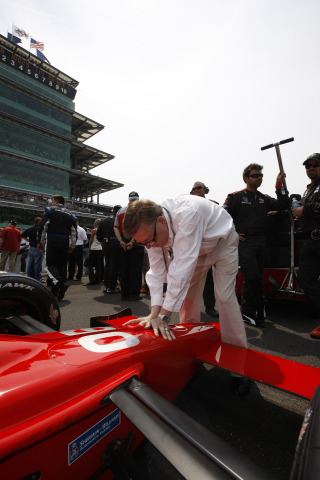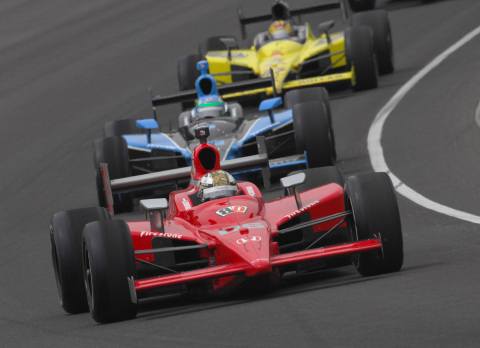The Way It Is/ Whither Tony George & IndyCar racing?
by Gordon Kirby Over the past week many people asked what I made of Robin Miller's story about Tony George's possible ouster from his job as CEO of the Indianapolis Motor Speedway. As you all know, the Speedway issued a statement later in the day which some people took as a clear denial and commitment to business-as-usual. But the statement quietly declared that big changes are afoot at the Speedway adding that George must present a plan later this year for the management of the Hulman-George family empire, "that would allow him to focus on the business which requires the greatest attention."
Over the past week many people asked what I made of Robin Miller's story about Tony George's possible ouster from his job as CEO of the Indianapolis Motor Speedway. As you all know, the Speedway issued a statement later in the day which some people took as a clear denial and commitment to business-as-usual. But the statement quietly declared that big changes are afoot at the Speedway adding that George must present a plan later this year for the management of the Hulman-George family empire, "that would allow him to focus on the business which requires the greatest attention."
All I can add is that I know Robin well. I've worked side-by-side with him in press rooms, pitlanes and garage areas across the United States and around the world. I know he has the best sources in the business and I believe that where there's smoke there's fire. I have no doubt Robin has the story essentially correct.
It's well-known that Tony George has spent a hell of a lot of money over the past thirteen years for very little return. Few will argue that Indy car racing or the Indy 500 are healthier today than they were a dozen and more years ago when Nigel Mansell came to race Indy cars as the defending world champion and Jacques Villeneuve leaped from CART and Indy 500 stardom to win the world championship two years later. A couple of years ago Carl Haas almost broke into tears as we stood beside one of Mansell's Newman/Haas Lolas from 1993.
"See that little Ford sticker there," Haas pointed out. "That was worth a coupla million dollars. Today, I can't get that for the whole car! Back then, with Nigel and Mario, we had twenty-five million in sponsorship. For quite a few years there, this thing was really healthy."

© LAT USA
Last fall his longtime partner PLN passed away--an incalculable loss, as we all know--and in today's economic climate Carl is having a tough time finding a way to keep the doors open on his race team. Newman/Haas/Lanigan has two talented young drivers in Graham Rahal and Robert Doornbos and some sponsorship from McDonald's but the future looks bleak for Indy car racing's second most successful team.
Over the past two years Haas's team has also undergone a substantial change in personnel. Many longtime crewman have left to go to work in NASCAR or start their own small businesses and there are more new faces than old in this year's team. But the team has shown its depth by making their cars competitive on the ovals this year.
Rahal qualified on the inside of the second row at Indianapolis and ran well for a while before crashing in the race. At Milwaukee last weekend Graham qualified an excellent second and ran a strong race to finish fourth behind Scott Dixon, Ryan Briscoe and Dario Franchitti. Last week I talked with Newman/Haas/Lanigan's general manager Brian Lisles about the effort the team has put in for its second year in the IRL series.
"We worked hard over the winter and I think our engineers and senior crew people made some good decisions about what we needed to work on," Lisles commented. "We have quite some way to go in knowledge of the car, which is basically an engineering function, but we also have some way to go in terms of organization to cope with the way the IRL series is run. Some of that will take time and some of it is about money, both of which we really don't have very much of.
"So you just do the best you can. We chose some new projects to do over the winter and we did learn a few things. We also did some pretty productive oval testing towards the end of last year, using up our test days, which certainly gave us a very good foundation for thought over the winter. We did an extra oval test before the start of the season which was also productive. Like everything else, there's no magic in it. It's just hard work and making the right decisions and trying to be as efficient as possible."
Lisles acknowledges the similar effort put in by KV Racing and stresses how much time, money and effort still is required to close the gap to Penske, Ganassi and Andretti-Green.
"I think we've made our cars better," Lisles remarked. "We're more consistent and a lot more comfortable at the ovals. Our cars don't scare our drivers anymore. But other teams have done the same, particularly KV Racing. They've run probably a parallel program to what we ran over the winter and it shows in their performance too.

© LAT USA
"Obviously, it's true that there is a very big gap between the top three teams and the rest of the IRL runners, let alone the people who transitioned over (from Champ Car). However, they are working for smaller and smaller returns for more and more effort. Our expectation was to be able to half the gap from where we started relatively easily. But then to half it again will take more effort and to get all the way where they are will take not only a lot of effort, but also a lot of time, because they have a lot of experience."
Lisles points out that time and experience are also essential factors in NHL breaking through to the front on any oval.
"In the oval races, and Indianapolis in particular, the only way you're going to do really well in the races is to do a lot of races," he said. "That's because the race is so different from all the running you do in practice. At Indianapolis, it's very difficult to know the offset both for your driver and your engineers for how it feels in practice and how it's going to feel in the race and how it's going to change over the duration of the race because you only do it once a year. I would say you need four or five years of continual experience to be able to be confident to race to win on the ovals.
"In the past when we used to do Indy with Mario and Michael we would get the car done for qualifying and we knew from feedback from Mario and Michael, and from what we had done over the years, that we needed to do two or three things to get the cars pretty much where we needed to be in terms of downforce and drag to race well. But we don't have that experience now and that will take time to develop."
A tight budget has limited the amount of wind tunnel and aerodynamic work NHL has been able to do.
"We have used the ARC wind tunnel in Indy using the Honda model," Lisles said. "But you fairly soon run out of the obvious things to do and thereafter it becomes financially quite inefficient because--and I don't want to criticize the model because it's a lot better than we would have otherwise--but it has a certain fidelity and the tunnel has a certain capability and the cars are so close now that it's extremely difficult to sort out what is actually an improvement and what isn't, and that gets very expensive. For the same reason we don't have any straightline testing program and don't anticipate being able to do that."

© LAT USA
"Graham is very young. He really doesn't have that many racing miles under his belt in absolute terms. This is the first year he's repeated in the same car in the same series and certainly from our point of view it really shows. He's much more consistent, much more able to give meaningful feedback and be accurate in what he says. Plus the experience he now has of racing on the mile-and-a-half tracks and at Indianapolis.
"You need to do a number of these races before you're comfortable as to how to race. It's one thing to have speed but you also have to learn how to overtake and where to position your car and how the race shakes-out. He learned very well last year and he's still learning, which is good.
"Robert had absolutely no oval experience at all and no understanding of the history of oval racing at all. It's all new for him. Every concept of what happens in the event and the way yellows pan out and how you deal with things is new to him. So it's a massive learning experience. It'll take him several more oval events to get confident in his racing craft.
"In terms of raw speed, if the car's good he has the capability of qualifying very well, which he showed in Kansas and at Indy, too. Unfortunately he didn't have the experience of how the car talks to you so he didn't recognize how close he was to the limit until he hit the wall. Some expensive lessons and hopefully lessons well learned."
As well as being the team's engineering chief Lisles oversees the budget at NHL so he's very well acquainted with the financial limits in Indy car racing today. But like many of us Lisles despises spec car racing and would like to see the sport take a fresh leap into developing 21st century technology.
"I think it would be a tremendous thing to actually have a chance to make a giant step for relevance for motor racing," Lisles ruminates. "Historically, motor racing has always been about going faster than the other guy and making it last for whatever the duration of the race is. Motor racing started because manufacturers wanted to prove that their car was either faster or more reliable than other manufacturers. Today, reliability in racing is a given. We don't really need to prove that anymore.
"Today, we know how to go fast and how to be reliable and a lot of people feel racing should be about efficient use of energy. Quite how you make that into something that's appealing to the public is a difficult question. The perception is that the public will only get interested in an event where there's wheel-to-wheel, man-on-man combat, which if you look back historically is not how motor racing has ever been.
"Certainly Indianapolis used to be filled with some of the world's most boring races but the fans still came. Part of the excitement was not the man-to-man, wheel-to-wheel racing but the fact that somebody was leading in this powerful or different car that might not make it to the end. Some of the excitement was, is it going to hang together and make it to the end? But today I think everybody's got locked into the thought that you have to have wheel-to-wheel racing.
"If they want to make racing something other than a spectacle, which is how it's evolving, even in Formula 1, then we need to choose a challenge which is worthwhile. What we need to prove is that we can go faster for longer with the same amount of energy than the other guy. Obviously, your engine and the fuel you use is a primary part of that but some quite powerful secondary parts are the aerodynamics and the weight of the vehicle. Weight is not so important at Indianapolis or many oval races because you don't slow and accelerate as much, but it's very important at short ovals and all road tracks and street courses."
Lisles's perspective is shared by leading, forward-thinking automobile manufacturers like Audi and Porsche who use motor racing as a showcase for their engineering. Guys like Dr. Wolfgang Ullrich at Audi and Dr. Thomas Laudenbach at Porsche have said to me repeatedly in recent years that their overall goal in going racing is to achieve better all-round efficiency from cleaner-burning fuel and better combustion to lighter overall weight of the entire car and its components. If the IRL wants to attract any of the Porsche Group's brands it surely will have to go in this direction. For his part, Lisles would also like to see the IRL move to lighter, more modern chassis as well as more fuel-efficient engines.
"We've tackled safety by mandating some substantial structures rather than doing much crash-testing," he observed. "Formula 1 do it the other way. They have a lot of crash-testing and the structure is up to you. That is expensive, of course, but it's the only way you can get a light structure that is also safe. The alternative way is to make something very big and beefy that is so big and strong that even if you don't execute very well it's still up to the job. But that's not a very efficient use of resources.
"Building a light chassis is not only good for the efficiency of the car in the big picture, it's probably good for the efficiency of the materials used to build it. Total life efficiency and cost is what we should all be striving for. For most engineers efficiency is one of the things they get excited about. Elegant efficiency is what most creative engineers get a big kick out of.
"It's the challenge that counts," Lisles continued. "And the point is racing was built as a showcase that you could meet the challenge better than your competitor and the challenge used to be about speed and reliability. Reliability is not a challenge anymore and within reason speed isn't either. But efficient use of energy under various circumstances certainly is a challenge that has yet to be fully understood and exploited, and of course, how you deal with all that is part of the challenge for the rulemakers."
I have to add that I was intrigued on raceday at Indianapolis to hear some remarks by the city's Channel 8 WISH-TV morning news anchor Scott Sander. Scott interviewed me about my Rick Mears book on his raceday morning show and at the end of our interview he added an editorial comment of his own. Sander said he agrees with me that the Indy 500 can only become the truly great race it once was by getting away from spec cars and rekindling a more open formula for competing chassis and engine builders.
"I don't believe the Indy 500 can truly come back until they get away from spec cars," Sander said. "The Indy 500 was always about innovation, new cars and new engines. That's what everyone wants to see. If you go and walk around the Speedway's museum innovation and new ideas are what it's all about."
Sander hardly represents the motorhead perspective of Brian Lisles or myself so I was delighted to hear that he is equally interested, as we are, in hoping to see Indy car racing recreate itself by returning to the driving spirit which propelled the sport for so many decades.
If Tony George winds up losing control of each of the IMS, the Hulman Co., and Clabber Girl, and running only the IRL as Robin Miller has reported and last week's IMS statement strongly inferred, then George's remaining mission should be very clear. He will have to focus every ounce of his energy and management ability on recreating Indy car racing both technically and commercially, a very tall order which would ask a lot of the most talented and motivated man or woman.
Amid this tangled web the Hulman-George family are right to worry about their future and their legacy, too.
Auto Racing ~ Gordon Kirby
Copyright 2009 ~ All Rights Reserved
Copyright 2009 ~ All Rights Reserved
Top of Page